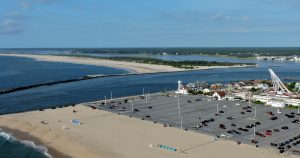
BERLIN – While planning continues, a long-term solution to Inlet depth concerns is at least five years away.
In a meeting last Thursday, representatives from the Maryland Department of Natural Resources (DNR) and the Army Corps of Engineers reviewed with local representatives the process for study and design of a major project to address the shoaling — or decreasing depth — of the Ocean City Inlet. They outlined a three-year feasibility phase followed by up to two years of design and implementation of a solution.
“This has been going on for decades,” said Worcester County Commissioner Chip Bertino, one of the local officials who attended Thursday’s meeting. “We certainly need to do something.”
Bertino and two of his peers, Commissioner Joe Mitrecic and Commissioner Bud Church, were among the roughly two dozen people who attended the meeting. A presentation from the Army Corps of Engineers (ACE) illustrated the three-year feasibility phase that would mark the start of the project as well as the 18-24 months of design and actual construction that would be needed to address the shoaling issue.
Attorney Mark Cropper, representing Sunset Marina and a variety of local fishing interests worried about the Inlet, said the timeline was frustrating but unavoidable when the ACE had to work within certain parameters.
“They have to work within well-defined boxes,” he said. “As frustrating as it may be to everybody there are very few ways to accomplish this goal other than having it set up with the Army Corps of Engineers.”
Church agreed that project’s progress was slow but said the he was pleased to see so many agencies working together for a specific cause.
“I’m satisfied that things are moving forward,” he said. “I’m a little disappointed it’s taken as long as it has but when you have as many agencies as we have it’s only natural. We’re further along now than we’ve ever been. I’m optimistic that in the next four to five months a lot of loose ends will be tied up.”
Nevertheless officials were advised at Thursday’s meeting that not all of the $1.2 million required for the feasibility study had been identified yet. Though the federal government will fund half the cost, that leaves $600,000 for state and local jurisdictions to contribute. Worcester County officials have agreed to provide $300,000 for the study and DNR has agreed to fund $200,000. Though Ocean City officials initially discussed using some of the resort’s beach replenishment funding to help cover the cost of the study, they opted not to, characterizing the Inlet’s depth as a county problem.
Bertino said funding had to be identified by February of 2019. He hopes resort officials will reconsider their position.
“I do hope Ocean City recognizes that it does impact the city and come around to allocate the $100,000,” he said. “Speaking for myself I don’t believe the county can allocate more.”
Though the increasingly shallow Inlet has created struggles for commercial fishermen for years, the issue is now a concern for recreational boaters as well. Pleasure yachts and charter boats have begun to run aground. A bathymetric survey performed by DNR in January shows a sizable portion of the Inlet with less than 9-feet of water. It’s as shallow as 7-feet in some areas.
“That could affect our white marlin tournament, a lot of tournaments in the area,” Bertino said. “It’s a real concern.”
Since discussions of a permanent solution began last year, the semi-regular maintenance dredging ACE performs in the region has continued. The two ACE dredges that handle the work, the Currituck and Murden, can be hired for additional dredging, though that comes at a cost of $21,600 a day. Based on the amount of sand that typically needs to be removed, officials estimate that maintaining a suitable depth in the Inlet would cost about $388,800 a year. While that remains an alternative, officials don’t believe it’s the ideal long-term solution.
“That gets expensive,” Bertino said.
The Worcester County Commissioners are expected to meet with Bill Anderson, DNR’s assistant secretary, during their regular meeting on April 17 for an overview of the project and what’s taken place so far.

